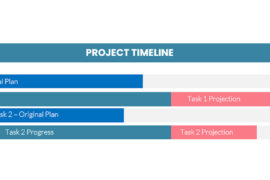 I tend to talk often in this column about “Enterprise” Project Management (EPM) Software. It’s a hot topic these days because so many organizations want to get their project management personnel to coordinate their actions and management often feels at the effect of a lack of consolidated project management reports. Organizations which do projects have an interest in such topics regardless of their size. So it’s perhaps worthwhile to take a moment and examine what project management software vendors mean by “the enterprise”
I tend to talk often in this column about “Enterprise” Project Management (EPM) Software. It’s a hot topic these days because so many organizations want to get their project management personnel to coordinate their actions and management often feels at the effect of a lack of consolidated project management reports. Organizations which do projects have an interest in such topics regardless of their size. So it’s perhaps worthwhile to take a moment and examine what project management software vendors mean by “the enterprise”
If we think of the spectrum of project management systems, it’s pretty easy to identify the opposite ends of the spectrum.
At one end we have the individual project manager. He or she is responsible for the projects which they impact directly or for which they provide schedule and other project analysis and reporting. In some organizations, there is only one project manager who only has a few projects to manage. In such a situation, this project manager wears all the hats. They do schedules, estimates, cost control, project tracking and project documentation.
With all the different roles such individuals play, it’s not surprising to find that they are most likely to have their own box of tools to get through their day. In the project management software realm, the most common two tools are Microsoft Excel or Microsoft Project. According to some estimates, there are about 35 million project managers using Excel as their primary project management tool and another 20 million using Microsoft Project. There is a plethora of other tools to be found that target this market from freeware to open source to tools of all descriptions. So, it’s fair to say that this part of the market is very well served by the project management software industry.
At the opposite end of the spectrum we have the ‘large enterprise’. The precise definition of such organizations is different from one project management software to another but suffice it to say that the big vendors think ‘big’ when they use the word ‘enterprise’. This typically means somewhere above 2000 employees and up to the largest organizations in the world of several hundred thousand employees.
When there are thousands of licenses of something to be sold, all kinds of large project management software vendors line up to try to get a piece of the action. There are several categories of vendor who focus on large enterprise project management solutions. In the ERP/Finance world we have the big players, SAP and Oracle who have finance-oriented solutions with project management and resource management modules. In the specialist camp we have the omnipresent Microsoft with a collection of tools referred to as the Microsft EPM Solution along with Primavera (now an Oracle company), Clarity from Computer Associates and Planview.
These large scale tools really need to be thought of as more of a building platform than a closed set of functionality. All of them arrive at the client’s door with tremendous potential and tremendous flexibility but little in the way of plug-and-play in the manner we think of the individual project management tools.
So far so good.
But, there is an incredible number of companies in between these two huge markets. The ‘mid-market’ is rather under-serviced and simultaneously rather over-promised.
Where the ends of the project management software spectrum at the individual and enterprise levels are served by a relatively small number of vendors and products, in the mid-market, there are hundreds if not thousands of possible options.
The market is characterized by demands that the implementation of organizational project management be as fast and inexpensive as the individual end of the spectrum but deliver the complex functionality and integration from the enterprise end of the spectrum. This is obviously not possible. The notion of ‘easy-to-use enterprise project management software’ is a fantasy. The concepts themselves aren’t easy and the culture change; the change-management aspect of the implementation can be terribly challenging. I’ve talked about these challenges in here before.
So what do you do if you’re in this no-man’s land of organizational size – let’s say between 50 and 200 employees?
There are probably a hundred different paths you can take. First, just as it is with all organizational solutions, it’s very important to start by defining the problem. What are the business problems you’re trying to resolve? If the problem is reporting based, perhaps you can overcome this by having a centralized super-user who will generate, analyze and publish reports. If the problem is resource oriented, perhaps you can look at combining tools to have a small central group of project managers distribute reporting information to all the other personnel. If the problem is team communications and collaboration, then perhaps one of the many collaboration tools can overcome this challenge without having to consider a large implementation of specialized project software.
If I was faced with such a challenge, here’s what my most likely response would be:
People
First I’d look to create a tiny (maybe just one person) Project Management Office. If there’s to be any coordination of efforts in the project management realm, it won’t happen by accident. There has to be a central rallying point for the initiative and for future evolution of the structure. Next, I’d look to create a very small cadre of experienced project managers and I’d dedicate them to the Project Manager role. This is one of the things that’s so rarely done and most executives don’t realize the cost due to lack of efficiency of not having specialist personnel in these roles.
Tools
I’d almost certainly leverage the low cost and quick-to-deploy individual project management tools but I’d look to extend them with some add-ons. If my challenge was team communications, I might consider using a collaboration tool, but I might also just look to see what I need the team to communicate about and see if there were tools that lent themselves to the process that could be managed centrally. If my challenge was reporting and viewing of project data, I’d consider one of the low-cost viewers for Microsoft Project or Primavera or a report writing tool.
Here are some add-on or mid-market targeted tools I might consider:
EasyTaskSync (www.easytasksync.com)
This tool moves data back and forth from Microsoft Project to Outlook, allowing a single project manager to get a lot of personnel involved in the project through a tool that is likely to be on everyone’s desktop.
DecisionEdge (www.decisionedge.com)
This report-writer produces a range of great looking reports from data contained in Microsoft Project or Primavera. The resulting reports can be made available over the web or in printed form.
EPMLive (www.projectpublisher.com)
EPMLive hosts Project Server with a pre-set list of functions. Views, User Defined Fields, structures are set up in an attempt to make the big Project Server system a little easier to swallow.
Daptiv (www.daptiv.com)
While we’re talking about hosted systems, another option would be Daptiv who has portfolio management, scheduling and resource management in a web-based structure.
Microsoft Project Viewers
SteelRay Project Viewer (www.steelray.com)
Afinion Project Viewer (www.afinion.com)
Seavus Project Viewer (www.seavusprojectviewer.com)
Houstatonic Project Viewer (www.projectviewercentral.com)
Live Project Viewer (www.kadonk.com)
Each of these claim to be the top Microsoft Project Viewer on the market and I’m sure there are a hundred more.
When you’re in the massive mid-market for organizational project management software, there’s unfortunately no clear leader or small number of tools which dominate the market. You’ll need to be a little more crafty and put in a little more homework before you land on just the right combination of tools to get to the particular solution that’s appropriate to you.
Remember the basics: Articulate the particular business problem you want to resolve with these project management tools and make sure the vendors you talk to are ready to empower this thinking at the appropriate level for what you require.




